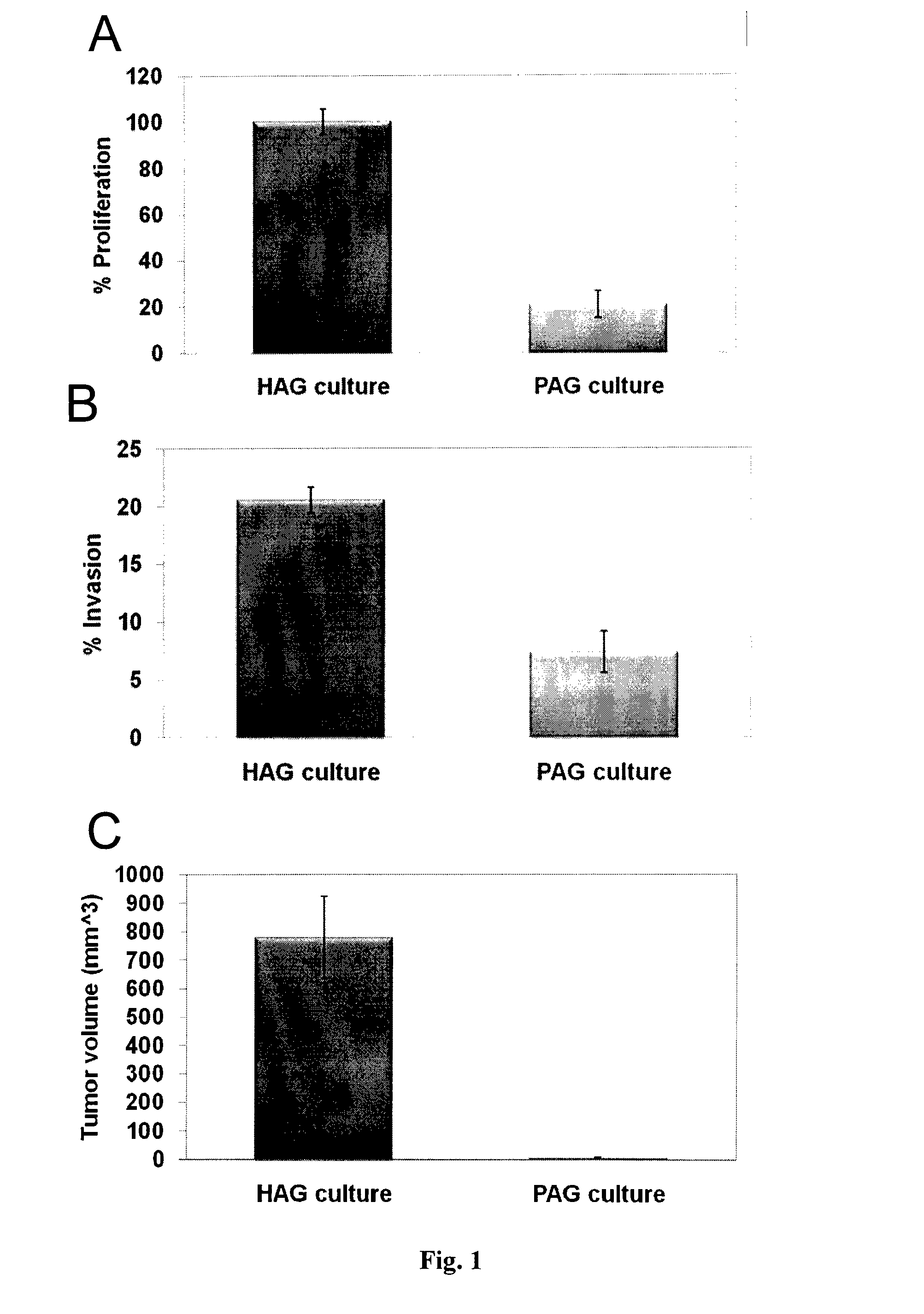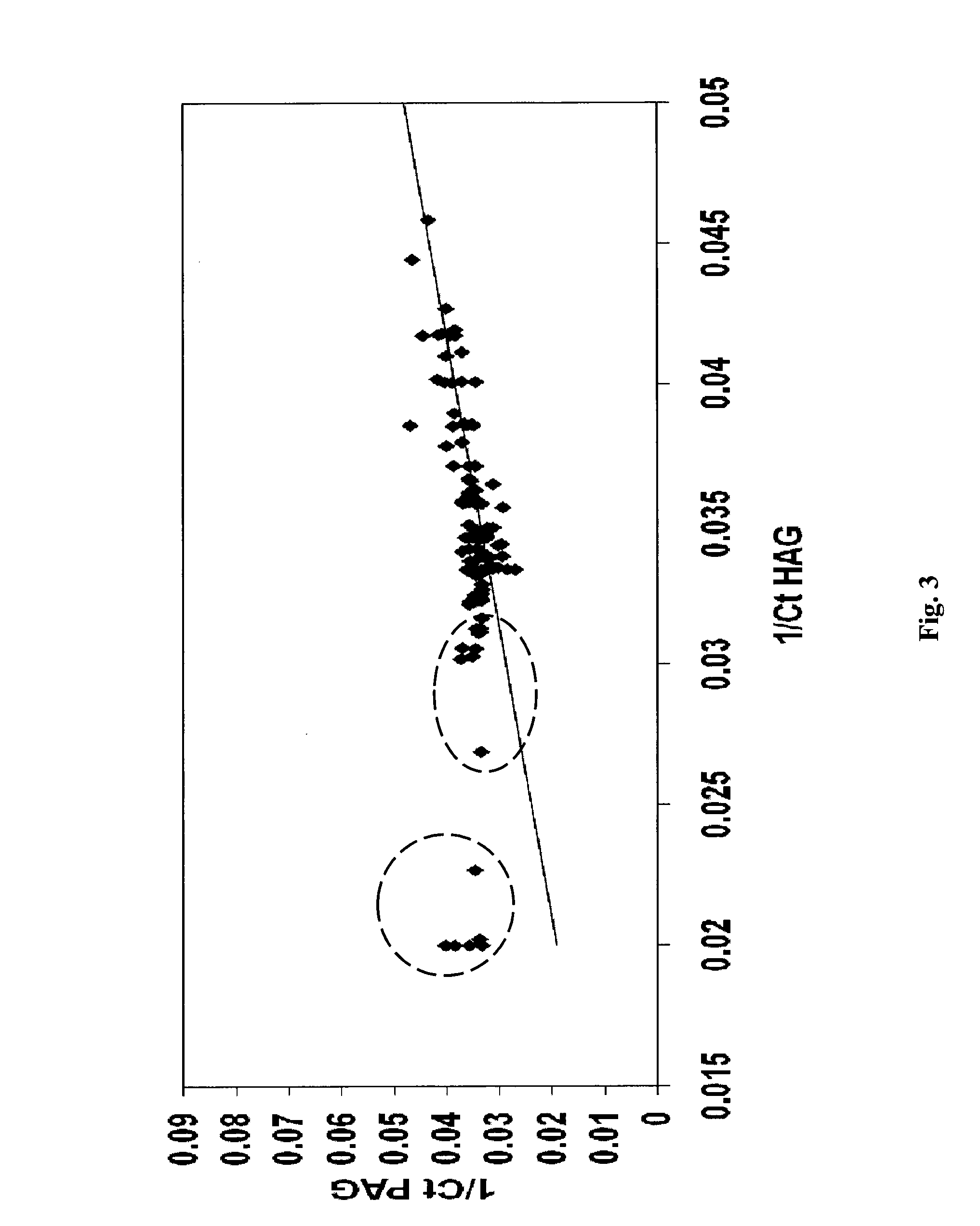Microrna patterns for the diagnosis, prognosis and treatment of melanoma
a microrna pattern and melanoma technology, applied in the field of microrna patterns for the diagnosis, prognosis and treatment of melanoma, can solve problems such as extreme difficulty in treatment, and achieve the effect of positive outcom
- Summary
- Abstract
- Description
- Claims
- Application Information
AI Technical Summary
Benefits of technology
Problems solved by technology
Method used
Image
Examples
example 1
Identification of miRs Patterns Associated with Aggressive Cancer Phenotype
[0166]The highly aggressive (HAG) C8161 and poorly aggressive (PAG) CS1-61 cutaneous melanoma cell lines were derived from different metastases from the same patient.
[0167]In order to identify miRNA patterns associated with aggressive phenotype of melanoma cells, a comparative qPCR-based high throughput analysis of human miRNAs (following ABI protocol) was performed on the melanoma sublines C8161-HAG and C8161-PAG.
[0168]Proliferation of HAG and PAG cells was measured with standardized XTT for 48 hours. The proliferation value for HAG cells was determined as 100%. Invasion ability of HAG and PAG cells was determined by 18 h matrigel invasion assay, which was corrected for proliferation. Tumorigenic potential of HAG and PAG cells was determined by SC injection of 1×106 cells into SCID-NOD mice. FIG. 1 shows the mean tumor volume within 18 days.
[0169]As shown in FIG. 1, the HAG cells are Highly Aggressive cells,...
example 2
Forced Expression of Suppressive miRs Inhibit HAG Cells
[0174]Exemplar human miRs-31,-34a, -133a, -184,-185 and -204 were identified as suppressive miRs according to the HAG / PAG differential analysis. These miRs were cloned into PQCXIP retrovial vectors and introduced into HAG cells. An empty vector was used as control (Mock). Transfectants were tested in vitro in proliferation, invasion and tube formation in 3D matrix.
[0175]Proliferation of HAG transfectants was monitored by standardized XTT for 48 h and the values of Mock-transfected HAG cells were determined as 100%. Invasion ability of HAG transfectants was monitored by 18 h matrigel invasion assay with correction for proliferation where the values of Mock-transfected HAG cells were determined as 100%. Tube formation was monitored 48 h after seeding of transfectants in matrigel.
[0176]Forced expression of all of the above miRs in HAG cells resulted in inhibition of the abovementioned cancer functions (FIG. 4).
[0177]Specifically, a...
example 3
In vivo Expression of Suppressive miRs
[0182]miRs-31,-34a, -184 and -185 were also tested in vivo in order to confirm the results obtained in vivo. HAG transfectants (300,000 cells / mouse) were injected SC into SCID-NOD mice. Each type of transfectant was injected to 6-8 mice. Formation and growth of tumor masses were monitored 2-3 times a week using a caliper. On the day of the last measurements, mice were sacrificed and tumors were extracted. The results indicate that tumor growth is inhibited or slowed down upon transfection with miRs-31, -34a, -184 and -185 relative to mock (FIG. 7A). This observation was verified by the actual size of representative tumors extracted at day 30 of the treatment (FIG. 7B). In addition, the abdominal cavity of all mice was opened and inspected for the presence of macro-metastases. As shown FIG. 7C the percentage of mice bearing intra-abdominal macrometastases following transfection with -34a, -184 and -185 is significantly low relative to control. Th...
PUM
| Property | Measurement | Unit |
|---|---|---|
| depth of | aaaaa | aaaaa |
| size | aaaaa | aaaaa |
| weight | aaaaa | aaaaa |
Abstract
Description
Claims
Application Information
 Login to View More
Login to View More - R&D
- Intellectual Property
- Life Sciences
- Materials
- Tech Scout
- Unparalleled Data Quality
- Higher Quality Content
- 60% Fewer Hallucinations
Browse by: Latest US Patents, China's latest patents, Technical Efficacy Thesaurus, Application Domain, Technology Topic, Popular Technical Reports.
© 2025 PatSnap. All rights reserved.Legal|Privacy policy|Modern Slavery Act Transparency Statement|Sitemap|About US| Contact US: help@patsnap.com



